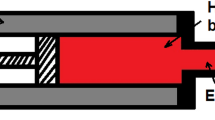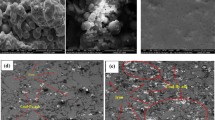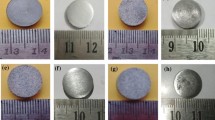Abstract
Products developed through the powder metallurgy route have significantly contributed to structural application, automotive, and aircraft industry in the last decades. Several research works are available on the use of pure metal powder for the development of useful products through the powder metallurgy process. The study on the physical and mechanical properties of compacted reduced composite fines produced after crushing of reduced composite briquette containing Blast furnace flue dust, iron oxide, graphite powder, and fly ash is limited. The physical property such as density of green briquettes made with reduced composite fines, and 0.5% sodium silicate has been measured as a function of compaction pressures (75, 90, and 100 MPa). The maximum density of 5341.6 kg/m3 was achieved at 100 MPa pressure. The samples possessing maximum density has been sintered at different temperatures of 1100 °C, 1150 °C, and 1200 °C for 60 min, 90 min, and 120 min respectively. The density, compressive strength, and hardness were measured after sintering of the samples. The samples were sintered at 1150 °C for 120 min achieve maximum density of 6111.4 kg/m3, compressive strength of 238.72 MPa, and hardness of 109.34 VHN.










Similar content being viewed by others
References
Galanty M, Kazanowski P, Kanuswan P, and Misiolek W Z J Mater Process Technol 125 (2002) 491.
Ordiales M, Iglesias J, Gonzales D F, Gorostiaga J S, Fuentes A, and Verdeja L F, Metals 6 (2016) art. ID 203. https://doi.org/10.3390/met6090203
Bardhan P K, Patra S, and Sutradhar G, Mater Sci Appl 1 (2010) 152. Doi:https://doi.org/10.4236/msa.2010.13024
Narasimhan K S, Adv Perform Mater 3 (1996) 7. DOI: https://doi.org/10.1007/BF00136857
Kruzhanov V S, Powder Metal Metal Ceram 57 (2018) 431. DOI: https://doi.org/10.1007/s11106-018-0002-1
Tiwari S, Rajput P, and Srivastava S, Int Scholar Res Network SRN Metal (2012) Article ID 195654. DOI: https://doi.org/10.5402/2012/195654
Bouvard D, Powder Technol 111 (2000) 231. DOI: https://doi.org/10.1016/S0032-5910(99)00293-4
Das R, Mondal M K, and Pramanik S, J Inst Eng India Ser D 102 (2021) 173.
Naransimhan K S, Mater Chem Phys 67 (2001) 56.
Wang W F, J Mater Eng Perform 16 (2007) 533. DOI:
Kung K Y, Horng J T, and Chiang K T, Int J Adv Manuf Technol 40 (2009) 95. DOI: https://doi.org/https://doi.org/10.1007/s00170-007-1307-2
Eksi A K and Yuzbasioglu A H, Mater Des 28 (2007) 1364. Doi:https://doi.org/10.1016/j.matdes.2006.01.018
Kwon Y S and Savitskii A,J Mater Synth Process 9 (2001) 299. DOI: https://doi.org/https://doi.org/10.1023/A:1016356305654
Upadhyaya G S, Sci. Sinter. 43 (2011) 3. DOI:https://doi.org/10.2298/SOS1101003U
Somerville M A, J Sustain Metall 2 (2016) 228. DOI https://doi.org/10.1007/s40831-016-0057-5
Gupta R C, Misra S N, ISIJ Int 41 (2001) S9.
Iguchi Y, Kamei R, Tetsu Hagane 85 (1999) 13.
Acknowledgements
The authors are thankful to the NIT Durgapur for all kinds of support. We want to thank the SAIL- DSP and DVC- Durgapur for providing the raw materials.
Author information
Authors and Affiliations
Corresponding author
Ethics declarations
Conflict of interest
No other funding agency funded this project. The experiments were carried out in the laboratories of Metallurgical and Materials Engineering Department, NIT Durgapur.
Additional information
Publisher's Note
Springer Nature remains neutral with regard to jurisdictional claims in published maps and institutional affiliations.
Rights and permissions
About this article
Cite this article
Das, R., Mondal, M.K. & Pramanik, S. Strengthening Behaviour and Microstructural Properties during the Compaction of Reduced Blast Furnace Flue Dust—Fly Ash—Iron Metal Matrix Composite Fines using Powder Metallurgy Route. Trans Indian Inst Met 75, 2255–2263 (2022). https://doi.org/10.1007/s12666-022-02592-8
Received:
Accepted:
Published:
Issue Date:
DOI: https://doi.org/10.1007/s12666-022-02592-8




